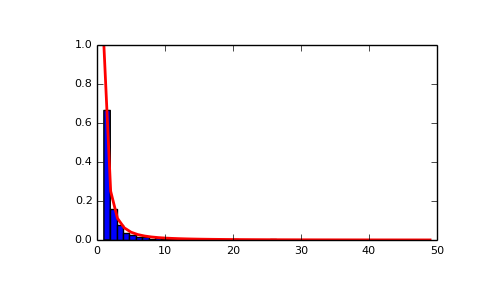numpy.random.zipf¶
- numpy.random.zipf(a, size=None)¶
Draw samples from a Zipf distribution.
Samples are drawn from a Zipf distribution with specified parameter a > 1.
The Zipf distribution (also known as the zeta distribution) is a continuous probability distribution that satisfies Zipf’s law: the frequency of an item is inversely proportional to its rank in a frequency table.
Parameters: a : float > 1
Distribution parameter.
size : int or tuple of int, optional
Output shape. If the given shape is, e.g., (m, n, k), then m * n * k samples are drawn; a single integer is equivalent in its result to providing a mono-tuple, i.e., a 1-D array of length size is returned. The default is None, in which case a single scalar is returned.
Returns: samples : scalar or ndarray
The returned samples are greater than or equal to one.
See also
- scipy.stats.distributions.zipf
- probability density function, distribution, or cumulative density function, etc.
Notes
The probability density for the Zipf distribution is
p(x) = \frac{x^{-a}}{\zeta(a)},
where \zeta is the Riemann Zeta function.
It is named for the American linguist George Kingsley Zipf, who noted that the frequency of any word in a sample of a language is inversely proportional to its rank in the frequency table.
References
Zipf, G. K., Selected Studies of the Principle of Relative Frequency in Language, Cambridge, MA: Harvard Univ. Press, 1932.
Examples
Draw samples from the distribution:
>>> a = 2. # parameter >>> s = np.random.zipf(a, 1000)
Display the histogram of the samples, along with the probability density function:
>>> import matplotlib.pyplot as plt >>> import scipy.special as sps Truncate s values at 50 so plot is interesting >>> count, bins, ignored = plt.hist(s[s<50], 50, normed=True) >>> x = np.arange(1., 50.) >>> y = x**(-a)/sps.zetac(a) >>> plt.plot(x, y/max(y), linewidth=2, color='r') >>> plt.show()
(Source code, png, pdf)
